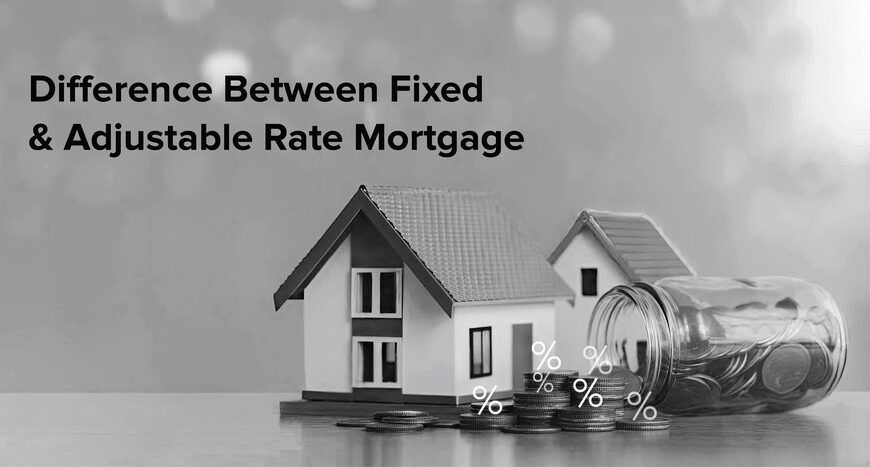If you are a home buyer, you will agree that finding the right property is your first challenge. Once you have zeroed in on the most suitable property, you are ready to face the next challenge, which is choosing the best type of mortgage. You must find a mortgage that meets your needs and budget since you are likely to pay back your mortgage over a long period.
While selecting a mortgage, one crucial decision you need to make is choosing whether to get a fixed-rate mortgage or an adjustable-rate mortgage. This blog will examine both types of mortgages in detail and highlight the differences between the two. This comparison will help you make a better decision that aligns fully with your goals.
Understanding Fixed-rate Mortgages
A fixed-rate mortgage is one of the most popular types of mortgage among home buyers because of its predictability. It maintains the same interest rate over the entire life of the loan. However, even if your principal and interest do not change, your overall payment may change based on the variations in your homeowners’ insurance and taxes.
Pros of Fixed-rate Mortgages
Fixed-rate mortgages offer these benefits to borrowers:
1. Predictable rates
The biggest benefit of this loan is that you know how much your interest rate and monthly payment will be, making it easier for you to plan accordingly. The reliability that fixed-rate mortgages provide is something you cannot expect in an ARM.
2. Makes budgeting easy
As it has a steady interest rate, it makes budgeting easier. You can easily predict your annual mortgage interest deductions on your tax returns in advance. Moreover, it helps you plan for an earlier mortgage payoff. By calculating the amount you will spend over the mortgage’s life, including interest-rate charges, you can calculate what you will save by paying off the loan early.
3. Comparing fixed-rate mortgages is simpler
As you only have to evaluate closing costs and rates, comparing fixed-rate mortgages is easier compared to an ARM, where you may need to compare factors like the initial rate or potential rate changes.
Cons of Fixed-rate Mortgages
We will now look at the disadvantages of fixed-rate mortgages:
1. Higher rates
Interest rates for these mortgages are higher than adjustable-rate mortgages, especially in the loan’s initial years. Consequently, you will be paying higher interest and a larger monthly payment if you live in the house only for a few years.
2. Qualifying may be tougher
As the monthly payments are higher, your lender may make stringent requirements to ensure you can cover these large payments.
Adjustable-rate Mortgages
The introductory rate at the beginning of your ARM loan is usually lower than fixed-rate mortgage rates. They are generally loans with a 30-year tenure. You will need to pay back the borrowed some over this period, with a fixed rate for an initial period. However, the interest rate changes after the fixed period ends and will adjust up or down.
Your lender will generally use a special series of structures to inform you about your ARM and its interest periods. One common ARM is a 5/1 loan, where the first number indicates the period your fixed interest rate will last, while the second number tells how often your interest rate will fluctuate. The 5/1 loan indicates it will change yearly, and if you see a 6 in place of the ‘1’, it will denote that the rate will change every 6 months after the expiry of the fixed period.
Pros of Adjustable-rate Mortgages
Let us examine the benefits ARMs offer:
1. Lower introductory rates
The lower introductory interest rates offer a significant advantage to lower-income borrowers looking to buy a new home. It is a more practical option for individuals early in their careers who expect their earnings to rise shortly, making it affordable to pay off the higher ARM payments that come later on.
2. Beneficial to short-term borrowers
ARMs are suitable for borrowers who only plan to keep their homes for a few years. Such people plan to sell off their homes before the introductory rate of their ARMs changes.
3. People with poor credit can access an ARM
The qualification process for an ARM is easier for people with poor credit. Their initial affordability and accessibility make ARMs a popular mortgage type.
Cons of Adjustable-rate Mortgages
Now let us look at the drawbacks of ARMs:
1. Unpredictable rates
Their unpredictable nature is their biggest disadvantage. Though ARMs have rate and payment caps, it can be difficult to anticipate how far your costs will rise and budget accordingly.
2. Risk can be higher
An ARM could cost more in terms of interest and monthly payments than fixed-rate loans if you plan to stay at your home for a long time. With interest rates increasing steadily, your ARM could cause a situation called negative amortization, where even after continuing to make full payments, you may actually end up owing more per month.
3. A higher down payment
The minimum down payment on an ARM is usually 5%, which is 2 points more than the 3% baseline down payment on conventional fixed-rate loans.
Choosing Between Fixed-rate Mortgages And Adjustable-rate Mortgages
You can opt for a fixed-rate mortgage if:
- You plan to reside in your home for a long period: In such a situation, fixed interest rates and payments make it easy to budget for your payment
- You prefer lower overall costs: Though ARMs are cheaper initially, the rates can increase or decrease in response to market conditions after your introductory period ends. A rise in the interest rate can lead to higher overall interest costs.
- If interest rates are low: Locking in a low rate in a low-interest rate environment will keep your payments lower over your loan’s term before rates rise eventually.
It is better to go for an ARM in the following situations:
- You plan to relocate before the fixed rate ends: If you plan to move out after a few years, your ARM could be a feasible option. The lower initial rate and payment lets you move before the rate increases.
- When interest rates are high: An ARM makes your new home more affordable because of its initial lower rate compared to fixed-rate loans. It is especially beneficial if you anticipate an increase in your income in the future because you can easily manage the higher payments that come after your loan begins adjusting.
Conclusion
Consider all the pros and cons of fixed-rate and adjustable-rate mortgages before coming to a final decision. In both cases, you will need to match your lender’s income and credit requirements to quality. Before applying for a fixed-rate or adjustable-rate mortgage, consider checking your credit score to see where you stand and take steps to improve your score if needed.
At Bond Street Mortgage, we use our years of experience to help you find mortgages at terms and costs that align with your budget and current financial status. We will consider all factors to help you decide which is better for your situation, fixed-rate or adjustable-rate mortgage.
To avail of a hassle-free mortgage process and the best rates, contact our team today!














